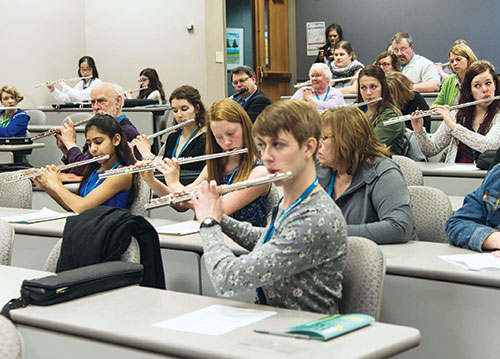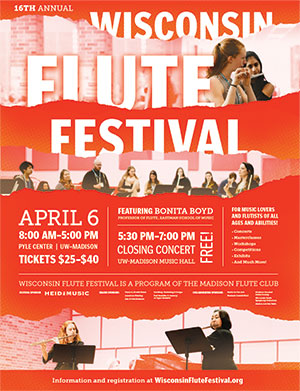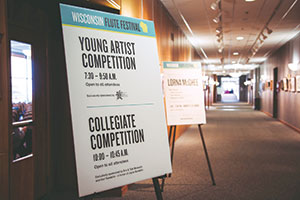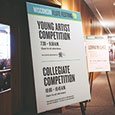This past April, the Madison Flute Club hosted the 16th annual Wisconsin Flute Festival. My involvement with the festival planning committee extends back to 2013, and 2019 marked my third year as Festival Director. Over the past seven years, it has evolved from a small, local festival, into a reputable, full-day event that draws participants from across the United States. The components of this success and growth include detailed attention to the target audience, festival format, budgeting, and marketing. The following are some ideas that can serve as a guide for developing a flute event.

Audience
Defining a target audience forms the foundation for an event. This could include anyone from beginning flutists to professionals. It also may include other musicians beyond flutists, community members, and music educators. Two goals of the Wisconsin Flute Festival are to connect flutists of all ages and abilities with one another and to present high-caliber performances of diverse flute repertoire to the attendees and Madison community. As a result, the target audience includes flutists of all ages and abilities as well as non-flutist concert-goers. When defining a target audience, create a profile for a typical or ideal attendee. What are their interests? How advanced are their musical skills? Where do they come from? Are they in a particular age range? How participatory of an experience do they want?
Format
Once you have defined a target audience, you are ready to create the format of the event. Since our target audience is quite broad, we strive to offer an option of interest to everyone for each hour of the day. This might be a performance and two or three participatory or lecture sessions on various topics. Past events have included Flute Lover’s Warm-up Exercises, Navigating Orchestral Auditions, Making Good Recordings, Style and Genre in Tele-mann’s Fantasias, Piccolo Techniques, Low Flutes Petting Zoo, and Yoga for Flutists, as well as flute choir reading sessions and masterclasses. There is also an exhibit hall with flute manufacturers and retailers from across the country that is open for the duration of the festival. We offer three levels of competitions for middle school, high school, and collegiate flutists with plans to add additional competitions, as funding permits.
Based on the target audience, however, the format for your event might be quite different. Private studio teachers seeking potential students could host a flute day that includes an informational session on choosing an instrument, instrument assembly and care, and private lessons. Participating in group classes and playing in ensembles with current students creates an enjoyable and inclusive introduction to your studio.
A university seeking to recruit students or to interact with the local community might offer a flute day to connect with flutists from the region or around the state. This type of flute day could offer sessions on pursuing music in college, choosing a college, and audition preparation. A final concert might allow attendees an opportunity to play in an ensemble with current students and watch a performance by the professor and university students. Opening the final concert to the public at no charge can strengthen the relationship with the local community by providing an invitation onto campus and access to the arts.

An example of a promotional poster
Budget
Developing a budget is imperative to running a financially responsible event. During my time as festival director we have taken steps to drastically improve our budgeting process, developing a robust template that provides the financial framework during the planning process. If you are starting from scratch, sketch out a list of all possible expenses with cost approximations. It is best to over-estimate expenses during the early years of an event, as there are almost always surprises, and be conservative in estimating income. Some of the major expenses that we incur are venue rental, piano moving and tuning, guest artist fee, competition prize money, and marketing.
Earned revenue streams for the Wisconsin Flute Festival include registration, competition and masterclass fees, advertisements, exhibitor registration, lunch purchases, and more. Registration is the most significant source of earned revenue, so the financial stability of the event relies on a strong turnout. Contributed revenue streams, monetary and in-kind (contributed goods or services) donations, provide approximately 55% of our revenue. Donations from generous individuals, monetary sponsorships provided by specialty flute companies and flute makers for featuring one of their artists, and in-kind donations of pianos and design services are examples of contributed revenue that we pursue. As a practice, we record in-kind donations as income and also as an expense so there is a full accounting of what it takes to produce the festival. As a non-profit organization, we also have the opportunity to apply for grants from foundation and government sources and utilize university and community space for reduced cost.
Marketing
Marketing an event can be done through a variety of mediums including social media, e-mail, print, radio, and television platforms. The quality of the marketing materials matters greatly in today’s world of media-saturated consumers. All materials should be in full color, and if you lack adequate design experience, consider employing a graphic designer to assist with the creation of promotional materials. We partner with a local graphic design firm, in exchange for sponsorship recognition, to create marketing materials that can be adapted for digital and print marketing. The marketing strategy that works effectively for us is:
• A dedicated, modern website, that is scalable for desktop and mobile viewing, with all pertinent registration and festival information.
• A Facebook page and Instagram account to promote the festival with information about the guest artist, presenters, performers, exhibitors and sponsors. Paid and organically promoted posts are utilized on Facebook.
• A small quantity of 11"x17" posters with essential event information to distribute to local schools, businesses, and community event boards.
• A moderate quantity of 8.5"x11" posters to distribute through the state library system for display in all public and academic libraries.
• A large quantity of postcards that are mailed to school music programs around the state and to larger flute retailers and local music stores for distribution in their shipments and stores. Non-profit bulk mail rates are quite affordable.
• A press release sent to local radio and television stations and print media.
• Selective follow-up with a personalized e-mail to the most relevant media contacts.
• Advertisements on websites such as the National Flute Association and local city and regional events calendars.
Develop a timeline for when to implement these strategies. Always allow for slow responses or time for additional marketing measures if needed when creating this plan.
Appeal
Every interaction attendees have with an event, from the first promotional materials they encounter, to the registration process, to subsequent communication about the festival, needs to be high quality. While the offerings of any festival or event are arguably the most important aspect, spend some time and attention on the little things such as branded lanyards and name badges, welcoming and clear directional signage, detailed program books, and well-trained volunteers. These small details add significantly to the quality of your event.

We strive to make the Wisconsin Flute Festival an attractive event to attend and pride ourselves on hosting an event that is professional, educational, and enjoyable for all involved.
Wisconsin Flute Festival Planning Timeline: PDF






